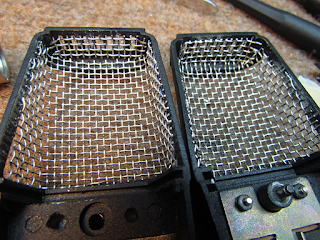 After reading a lot about the semi-famous Oktava MK-219 and MK-319 microphones online, and the various mods to improve them, I took the plunge and procured some used ones.
After reading a lot about the semi-famous Oktava MK-219 and MK-319 microphones online, and the various mods to improve them, I took the plunge and procured some used ones.Here's the first victim, an MK-219 from 2001. This mic is a large diaphram condenser mic which sounds pretty decent unmodified. But there are a lot of popular mods to improve...or change it.
The microphones are made in Oktava's factory in Tula, the adminstrative center of the Tula Oblast in Russia.
I used Scott Dorsey's article as a reference point, as well as other references on the interwebs. If you do a search, you'll find a lot of information about these mics.
The most basic mod is to cut away the bars on the headshell around the capsule to open it up, and to add deadening material to the body to cut down on the 'ringing' produced when the mic is vibrated, which affects the tone.
First we'll take on the mods to the body.
It's easy to open up; take off the ring around the XLR socket, then remove the screw that holds the body halves together.
Some of these pop right apart, but this one was really tight. There are two brass shims between the XLR connector and the inside of the body to tighten it up.
I used a wood wedge to drive the body halves apart. I didn't want to scratch the paint off, so I didn't use something metal to do this.
Here's the body, now separated. You can see the two shims I mentioned which came out when I opened it up.
The pc board is held into place with a threaded rod which also accepts the screw we took out earlier.
Just unscrew the rod. And don't lose it!
The body halves with the chassis removed.
Be careful around the microphone capsule at the top! If it gets punctured it will cease to work.
I put the whole chassis safely aside while I worked on the body.
If you tap one of the body halves, you can hear it ring instead of 'thunk.' We're going to remedy that.
But first, we're going to cut the bars out of the top of the body and put new mesh in.
The stock mesh comes out easy - just pry it out. It's not glued in.
The bars at the top around the capsule limit the amount of sound that can get picked up. We cut them off with snips.
They're close together, so I used small snips to start cutting in one area, then I used larger snips to cut the remainder away.
I left little nubs of material on the body rather than try and cut the whole thing level with the frame.
While I was cutting, I had the occasional 'ping!' when a chunk of material flew off and went into never-never land.
Then I ground down the nubs as far as I dared with my trusty Dremel tool and a grinding attachment.
Then I filed the nubs down flat.
Bars are all gone and the area where they were is flat. I sanded the bare metal with 220 grit paper, then primed it and painted it with Rustoleum 'Textured Surface' black paint.
Some folks take one of the two layers of factory mesh out and leave one. The mesh is there to make a Faraday cage to cut out RF.
The stock mesh as seen on the left has about 22 or so openings per inch. The nice Microphone-Parts.com headbasket I put on my modified MXL 990 has about 10 or so openings per inch.
I followed that lead and procured some mesh from McMaster-Carr with more openings to use instead of the stock mesh.
Traced the stock mesh onto the new screen and cut it with snips. It took a couple of tries to get ones that fit nicely.
This is stainless steel mesh screen - I bought a sheet with 10 spaces per inch and one with 12. I wound up using the one with 12 spaces for this project.
I found that the mesh with more spaces is a lot easier to bend to shape. The screen with less spaces (such as the screen I used) is a lot stiffer and harder to work.
The mesh/screen must be grounded to act as a Faraday cage, so you need to scrape some paint off the area where the screen mounts. After you put the screen in, just test it for continuity to the body.
Here's a test fitting. There are small screens at the top of the opening, so I did those with the new screen as well.
One of the issues with the MK-219 body is that it rings when you tap it. That ringing can be picked up by the mic when you're recording. So the body needs to be damped.
Scott Dorsey and others have used RTV silicone to damp the body. That looked like a real mess to work with, so I decided to simply use some CLD (Constrained Layer Damper) tiles left over from my SAAB c900 sound deadening project. I put one large piece and one small piece on each half.
I probably used more than I needed, but I figured I'd put a big hunk in there for good measure.
Works amazingly well and it's a more elegant solution than the silicone I think. And nowhere near as messy.
Next time we'll work on the electronics.



















0 comments:
Post a Comment